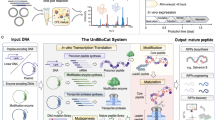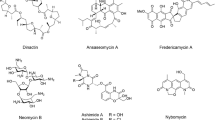Abstract
The sensitivity of the cell-free protein synthesis systems from Acidanus brierleyi, Acidianus infernus, and Metallosphaera sedula, members of the archaeal order Sulfolobales, to 40 antibiotics with different specificities has been studied. The sensitivity patterns were compared to those of Sulfolobus solfataricus and other archaeal, bacterial, and eukaryotic systems. The comparative analysis shows that ribosomes from the sulfolobales are the most refractory to inhibitors of protein synthesis described so far. The sensitivity results have been used to ascertain in phylogenetic relationships among the members of the order Sulfolobales. The evolutionary significance of these results are analyzed in the context of the phylogenetic position of this group of extreme thermophilic microorganisms.
Similar content being viewed by others
References
Altamura S, Sanz JL, Amils R, Cammarano P, Londei P (1988) The antibiotic sensitivity spectra of ribosomes from the Thermoproteales: phylogenetic depth and distribution of antibiotic binding sites. System Appl Microbiol 10:231–240
Amils R, Sanz JL (1986) Inhibitors of protein synthesis as phylogenetic markers. In: Hardesty B, Kramer G (ed) Structure, function and genetic of ribosomes. Springer Series in Molecular Biology, Springer Verlag, New York, pp 605–620
Amils R, Ramírez L, Sanz JL, Marín I, Pisabarro AG, Ureña D (1989) The use of functional analysis of the ribosome as a tool to determine archaebacterial phylogeny. Can J Microbiol 35:141–147
Amils R, Ramírez L, Sanz JL, Marín I, Pisabarro AG, Sánchez M, Ureña D (1990) Phylogeny of antibiotic action. In: Hill WE, Dahlberg A, Garret RA, Moore PB, Schlessinger D, Warner JR (ed) The ribosome. American Society of Microbiology, Washington DC, pp 645–654
Böck A, Bär U, Schmid G, Hummel H (1983) Amino-glycoside sensitivity of ribosomes from the archaebacterium Mathanococcus vannielii: structure-activity relationships. FEMS Microbiol Lett 20: 435–438
Cammarano P, Teichner A, Londei P, Acca M, Nicolaus B, Sanz JL, Amils R (1985) Insensitivity of archaebacterial ribosomes to protein synthesis inhibitors. Evolutionary implications. EMBO J 4: 811–816
Dixon WJ, Brown MB, Engelman L, Frane JW, Hill MA, Jennrich RI, Toporek JD (1983) BMDP statistical software. University of California Press, Berkeley
Hilper R, Winter J, Hammes W, Kandler O (1981) The sensitivity of archaebacteria to antibiotics. Zentralbl Bakterol Hyg, I Abt Orig C 2:11–20
Huber G, Spinnler C, Gambacorta A, Stetter KO (1989) Metallosphaera sedula gen. and sp. nov. represents a new genus of aerobic, metal-mobilizing, thermoacidophilic archaebacteria. System Appl Microbiol 12:38–47
Hummel H, Bär U, Heller G, Böck A (1985) Antibiotic sensitivity patter of in vitro polypeptide synthesis systems from Methanosarcina barkeri and Methanospirillum hungatei. J Biol Chem 260: 529–533
Montandon PE, Wagner R, Stutz E (1986) E. coli ribosomes with a C912 to U base change in the 16S rRNA are streptomycin resistant. EMBO J 5:3705–3708
Noll KM (1989) Chromosome map of the thermophilic archaebacterium Thermococcus celer. J Bacteriol 171:6720–6725
Oliver JL, Sanz JL, Amils R, Marin A (1987) Inferring the phylogeny of archaebacteria: the use of ribosomal sensitivity to protein synthesis inhibitors. J Mol Evol 24:281–288
Sanz JL, Altamura S, Mazziotti I, Amils R, Cammarano P (1987) Unique antibiotic sensitivity of an in vitro polypeptide synthesis system from the archaebacterium Thermoplasma acidophilum. Phylogenetic implications. Mol Gen Genet 207:385–394
Sanz JL, Marín I, Ureña D, Amils R (1991) Functional analysis of seven ribosomal systems from extremely halophilic archaea. Can J Microbiol 38:311–317
Segerer A, Neuner A, Kristjansson JK, Stetter KO (1986) Acidianus infernus gen. nov., sp. nov., and Acidianus brierleyi comb. nov.: facultatively aerobic, extremely acidophilic thermophilic sulfur-metabolizing archaebacteria. Int J System Bacteriol 36:559–564
Sor F, Fukuhara H (1984) Erythromycin and spiramycin resistance mutations in the mitochondrial gene coding for the large rRNA gene in yeast. Nucleic Acids Res 12:8313–8318
Stetter KO (1993) The lesson of archaebacteria. In: Benstson S (ed) Early life on earth: Nobel symposium No 84. Columbia University Press, New York (in press)
Swofford DL (1981) On the utility of the distance Wagner procedure. In: Funk VA, Brooks DR (ed) Advances in cladistics. New York Botanical Garden, New York, pp 25–43
Swofford DL, Selander RB (1981) BIOSYS-1: a FORTRAN program for the comprehensive analysis of electroforetic data in population genetics and systematic. J Hered 72:281–283
Vázquez D (1979) Inhibitors of protein biosynthesis. In: Kleinzeller A, Springer GF, Wittmann HG (ed) Molecular biology, biochemistry and biophysics 30. Springer Verlag, Berlin
Wächterhäuser G (1990) The case for the chemoautotrophic origins of life in an iron-sulfur world. Orig Life 20:173
Woese CR, Kandler O, Wheelis ML (1990) Towards a natural system of organisms: proposal for the domains Archae, Bacteria, and Eucarya. Proc Natl Acad Sci USA 87:4576–4579
Woese CR, Pace NR (1993) Probing RNA Structure, Function, and History of Comparative Analysis. In: Gesteland RF, Atkins JF (ed) The RNA world. Cold Spring Harbor Laboratory Press, Cold Spring Harbor, NY, pp 91–135
Wool IG (1984) The mechanism of action of the cytotoxic nuclease α-sarcin and its use to analyse ribosome structure. Trends Biochem Sci 9:14–17
Yamagishi A, Oshima T (1990) Circular chromosomal DNA in the sulfur-dependent archaebacterium Sulfolobus acidocaldarius. Nucleic Acids Res 18:1133–1136
Author information
Authors and Affiliations
Additional information
Correspondence to: R. Amils
Rights and permissions
About this article
Cite this article
Sanz, J.L., Huber, G., Huber, H. et al. Using protein synthesis inhibitors to establish the phylogenetic relationships of the sulfolobales order. J Mol Evol 39, 528–532 (1994). https://doi.org/10.1007/BF00173422
Received:
Accepted:
Issue Date:
DOI: https://doi.org/10.1007/BF00173422




